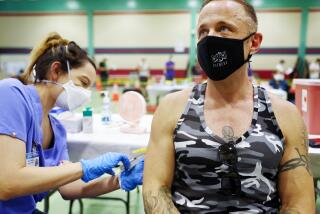Indiana hospital workers get clean bill of health after MERS scare

Dozens of hospital workers who were sent home and told to remain in isolation have tested negative for the deadly virus MERS and been cleared to return to work in Indiana, where the nation’s first case of the disease was confirmed earlier this month.
But as officials in Munster, Ind., announced the end of their MERS scare Monday, health experts in Florida were beginning to deal with another case there, underscoring the ailment’s potential to spread as carriers bring it in from the Middle East.
Both U.S. cases of MERS, short for Middle East Respiratory Syndrome, have been diagnosed in residents of Saudi Arabia who had recently flown to the United States. The World Health Organization says that since the virus was first detected in April 2012, there have been at least 536 confirmed cases and 145 deaths.
Most cases have occurred in Saudi Arabia, but MERS also has turned up across the Arabian Peninsula and in Greece, Germany, France, Italy, the United Kingdom, Malaysia, the Philippines, and most recently, the United States.
The first U.S. case was diagnosed in Munster, about 25 miles south of downtown Chicago, after an American man living and working in the Saudi capital, Riyadh, fell ill while visiting relatives in Indiana. He came to Community Hospital in Munster on April 28, and on May 2, the Centers for Disease Control and Prevention announced he had MERS.
The man was put in isolation to prevent the spread of the disease to healthcare workers and others. He was released from the hospital Friday and has been cleared to travel again.
In a statement Monday, health officials said the hospital workers who had been in contact with the unidentified man came up negative in their first round of tests and also tested negative in subsequent tests.
“These employees are cleared to return to work and discontinue home isolation,” the hospital said in a statement.
“The public can be reassured that there is no risk to the community, as there have been no reported cases of people without symptoms transmitting this virus to another person,” said the hospital’s chief medical information officer, Alan Kumar.
Symptoms of the disease include fever, coughing and respiratory distress, which led another Saudi resident recently arrived from Saudi Arabia to visit an Orlando, Fla., hospital on May 8. On Monday, the Centers for Disease Control and Prevention and Florida health officials announced the man had tested positive for MERS and that he had begun feeling ill on May 1.
Efforts were underway to alert hundreds of people who may have had contact with the unidentified man during a series of plane flights he made while traveling from Jidda, Saudi Arabia. His case was not believed linked to the Indiana one.
While MERS has a high mortality rate, health officials say it appears far less contagious than another coronavirus, SARS, which swept the globe in 2003 and killed hundreds of people, mostly in Asia. They believe MERS can only be spread through close and prolonged contact and after a MERS carrier is showing symptoms.
Many of the victims have been healthcare workers believed to have been exposed to MERS on the job.
But the coronavirus -- so-called because of its crown-like shape -- worries experts because there is no known cause and no treatment.
“Whenever you don’t fully understand a disease, it’s a problem,” said David L. Heymann, an epidemiologist and professor at the London School of Hygiene and Tropical Medicine. “The problem is that studies don’t tell us how this is transmitted to humans.”
MERS has been found in camels, but Heymann said determining how it jumped to humans would require extensive case control studies, which have not been done yet in Saudi Arabia.
More to Read
Start your day right
Sign up for Essential California for news, features and recommendations from the L.A. Times and beyond in your inbox six days a week.
You may occasionally receive promotional content from the Los Angeles Times.







